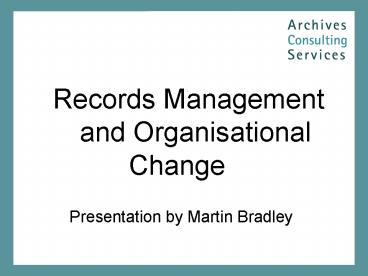Records Management and Organisational Change - PowerPoint PPT Presentation
1 / 21
Title:
Records Management and Organisational Change
Description:
Records Management and Organisational Change Presentation by Martin Bradley Staff Knowledge Management Will change affect staff turnover? Can no longer depend on ... – PowerPoint PPT presentation
Number of Views:235
Avg rating:3.0/5.0
Title: Records Management and Organisational Change
1
Records Management and Organisational Change
Presentation by Martin Bradley
2
(No Transcript)
3
Organisational Change
- Decentralisation
- Mergers
- Moving Offices
- New QA Procedures / Legislation
- Staffing Changes
4
The Issues
- Moving Archives / Records
- Staff Knowledge Management
- New Procedures / Regulations / QA
- Electronic Records the future?
5
Moving Archives/Records
- Where to put them? On / Off-site?
- How to ensure they arrive safely
- How to ensure they arrive in order
- Cost factors
- Risks?
- Space constraints 20 square metres
6
Staff Knowledge Management
- Will change affect staff turnover?
- Can no longer depend on individual familiarity
- Must have Policies and Procedures in place
- Cannot be solved by software
7
New Procedures / Legislation
- QA Issues - ISO 9000 -Transparency
- Data Protection Act 2003 Change
- Freedom of Information Act extension
8
Electronic Records the future
- Electronic Records need to be captured into the
same system as hard copy files - Electronic Records are not the exclusive domain
of the IT Department - Extra care needs to be taken, Email, SMS,
Messenger all legally admissible as records - Decisions need to be policy driven, not hardware
or software driven
9
How do you plan for change?
- Policy
- Procedures
- Training
- Implementation
- Certification
- Audit
10
How do you sell Records Management?
- TCI vs TCF
- Vital Records Business Continuity
- Administrative efficiency cost saving
- Public Perception - ISO
11
Incidence of having written document policy
Sector
Professional Services
Public Sector
Total
Finance
IT
Yes
No
Drury Research
12
Document Disposal when legal retention period is
uncertain
Store it indefinitely Ask advice on how
documents should be stored Store it for a
year Dispose of it anyway Dispose of it when
think its appropriate Other Dont know
Drury Research
13
Records Management Statistics
- Offices worldwide used 43 more paper in 2002
than they did in 1999 - The average organisation makes 19 copies of each
document, loses 1 out of every 20 documents and
office workers can each spend 400 hours per year
looking for lost files. - Between 1 5 of all documents are misfiled
- When e-mail is introduced into an office, the
percentage of printed documents increases by 40
per cent.
14
What is a Record?
- Information created, received and maintained as
evidence and information by an organisation or
person, in pursuance of legal obligations or in
the transaction of business ISO 15489 - Format and Medium not primary issue Identify
what are Records and include them in Records
Management Policy
15
Records Management Policy
- Assigns responsibility
- Covers all records
- Identifies Records at creation and follows their
life-cycle - Sets out Retention Periods
- Ensures Security and Business Continuity
- Enables legal destruction of listed records
16
Creating a Records Management Policy
- Survey and List all Records
- Create File Series Taxonomy
- Decide on Retention Periods
- Assign Responsibility
- Index and reference records create metadata
- Electronic Records mirror Hard Copy
- Accreditation and Audit
17
Choosing a Standard
- ISO 15489 Records Management Standard
- BIP 0008 Admissibility of E-Records
- BSI PD 5000 Admissibility of Emails
- MOREQ/MOREQ II
- ANSI/ARMA 5-2003 Vital Records Protection
18
ISO 15489
- European Standard
- Flexible
- Best International Practice
- Certification available
19
Benefits
- Legal compliance
- Administrative efficiency
- Public Perception - ISO Accreditation
- Cost savings manpower and storage
- Business continuity through Vital Records
20
Further Reading
- Archives Ireland www.archives.ie
- Society of American Archivists Moving Archives
- www.archivists.org/periodicals/aa_v66/review-engs
eth-aa66_2.asp - NSAI www.nsai.ie
- BSI www.bsi-global.com
- ISO www.iso.org
- ARMA www.arma.org
21
Martin Bradley Director Lo-Call 1850 786
748 Mob 087 286 2274 www.archivesconsult.com Inf
o_at_archivesconsult.com































